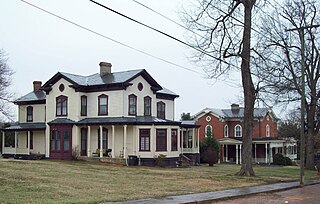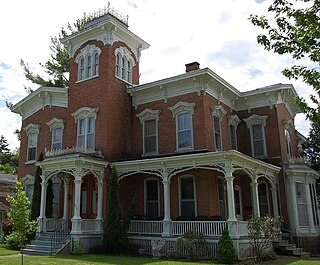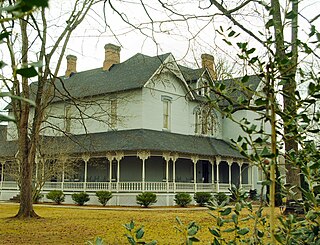
The Goodall Wooten House is a historic home built in 1898-1900 in Austin, Texas, USA. It was built by local doctor and benefactor Goodall H. Wooten and his wife Ella and was noted for its Classical Revival architecture and lush gardens. The building has served many purposes since passing out of the Wooten family in 1944, such as a student residence hall, a chemical dependency treatment center, a luxury hotel called "The Mansion at Judges' Hill" and currently, a boutique hotel called "Hotel Ella." The structure was added to the National Register of Historic Places on April 3, 1975.

The Craighead–Jackson House is a historic two-story, brick house in Knoxville, in the U.S. state of Tennessee. The home was constructed by John Craighead in 1818 across the street from the William Blount Mansion. The house is on the National Register of Historic Places.

Rose Mont is a Greek Revival style house built in Gallatin, Sumner County, Tennessee, United States. It was built by Judge Josephus Conn Guild for his family, and completed in 1842. Once the site of the area's largest thoroughbred horse farm with 500 acres (2.0 km2), it is now listed on the National Register of Historic Places as Rosemont. In 1993 the property was purchased by the City of Gallatin and the Rose Mont Restoration Foundation. The house is open to the public.

The Daniel's Hill Historic District is a national historic district located in Lynchburg, Virginia.

The Chapel of the Cross is a historic Episcopal church in the Mannsdale area of Madison, Mississippi. The brick structure was built circa 1850–52. It is noted for its Gothic Revival architecture, which draws heavily from 14th-century English country churches. It was added to the National Register of Historic Places in 1972.

The Farnam Mansion is a 19th-century mansion in the city of Oneida, which is located in Central New York State midway between the cities of Syracuse and Utica. Built circa 1862, it is situated on the southwest corner of Main and Stone Streets within the city's Main-Broad-Grove Streets Historic District, which was listed on the National Register of Historic Places in 1983.

Annandale Plantation was a historic cotton plantation and Italianate-style plantation house in what is now the Mannsdale neighborhood of Madison, Mississippi. The house was designed and built for Margaret Louisa Thompson Johnstone, the wealthy widow of John T. Johnstone. Completed during the late 1850s, it was destroyed in a fire during the mid-1920s. A replacement, part of a modern residential development, was later built at the site during the mid-20th century.

Two Rivers Mansion is an Antebellum historic house in Nashville, Tennessee, United States.

Riverwood is a privately owned historic house located in Nashville, Tennessee, United States. At 9,200 square-feet it sits on 8 acres of its original 2,500 acres. It has been a wedding and event facility since 1997.

The Ross-Sewell House is a house in Jackson, in the U.S. state of Tennessee.

The Fite-Williams-Ligon House is a historic mansion in Carthage, Tennessee in the United States.

The Cullum Mansion is a historic mansion in Carthage, Tennessee.

Beech Grove is a historic mansion in Nashville, Tennessee, USA. Built as a log house circa 1850, it was a Southern plantation with African slaves in the Antebellum era. In the 1910s, it became a livestock farm.

The Alfred Horatio Belo House is a historic mansion in Dallas, Texas, USA. It was built for Colonel Alfred Horatio Belo, a veteran of the Confederate States Army and founder of The Dallas Morning News, circa 1900. It remained in the Belo family until 1977, when it was acquired by the Dallas Bar Association.

For the Beaver Dam Plantation in North Carolina, see Beaver Dam Plantation House.

The Hall-Harding-McCampbell House is a historic mansion in Nashville, Tennessee, U.S..
Frank M. Riley was an architect of Madison, Wisconsin. A number of his works are listed on the National Register of Historic Places for their architecture.

Falcon Rest, also known as the Clay Faulkner House, is a historic house in Warren County, Tennessee. It was built in 1896-1897 for Clay Faulkner, the son of politician and mill owner Asa Faulkner, who lived at Falconhurst.

Greenlevel is a historic mansion in Collierville, Tennessee. It was built in 1833 for Judge John Overton, and it was home to a state senator and the mayor of Collierville. It is listed on the National Register of Historic Places.

The Stewart-Anderson House is a historic mansion in Tupelo, Mississippi. It was built in 1867. It served as the Tupelo Female Academy and it later became the private residence of state representative and senator W. D. Anderson, who also served as the mayor of Tupelo from 1899 to 1907.
















